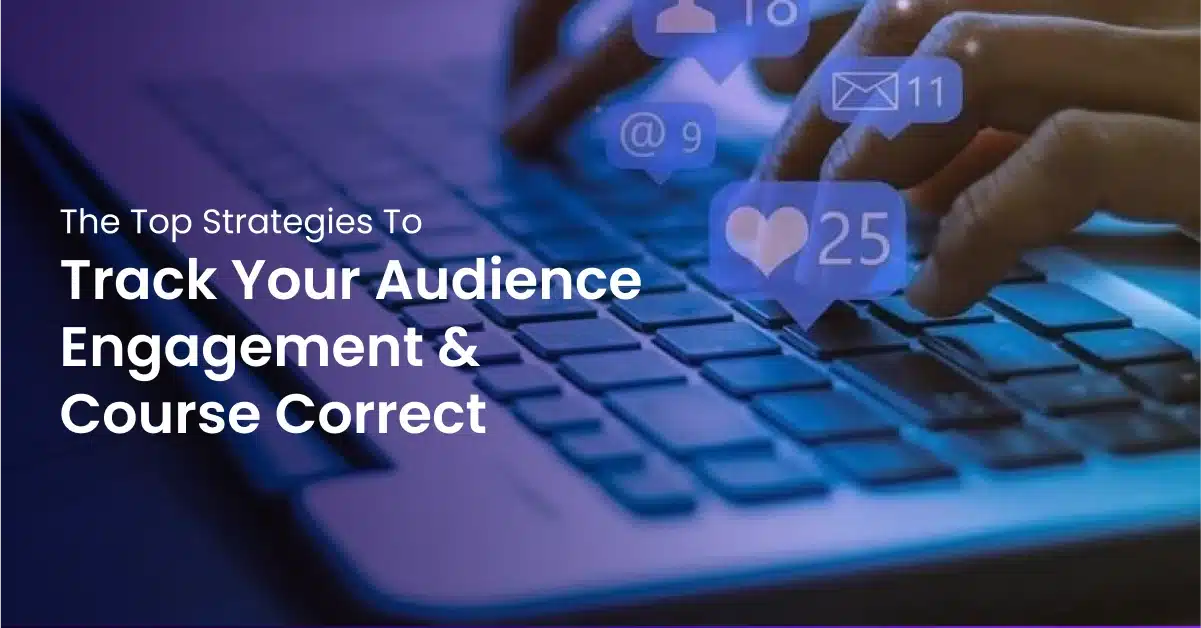

Audience engagement is the new essential goal that digital brands and publishers use. The reason is simple: highly engaged audiences are more likely to trust and share data about themselves. That means you can launch personalized campaigns that drive impressive results.
Build Your Audience Engagement Foundation
The path to audience engagement success starts with setting up the right foundation. The time and resources you invest will help you improve your audience engagement efforts in the long term.

1) Get To Know Your Audience Deeply
What does your audience want, and how do those needs align with your company goals? That’s the essence of audience research. Most audience needs relate to a few core drives, such as solving problems, pursuing gain, or entertainment. Surveys are an invaluable tool for getting to know your audience better.
Use questions like the following on your survey:
- What websites do you visit every week?
- Which social media platforms do you use most often?
- What type of content do you prefer the most (e.g., articles, videos, podcasts)?
If your last survey was 12 months ago (or longer), it’s time to update that information. Without these insights, your content and experiences may fail to connect with audience needs.
2) Align Engagement To Revenue Goals

Understanding your audience’s needs and wants is the beginning. Finding ways to align your goals with the audience is crucial.
For example, your audience may want to be the first to know important industry news to gain an advantage (or just brag about being the first to know!). That audience desire may align with a publisher’s goal to sell more paid subscriptions. To sell more subscriptions to this audience, look for ways to highlight how your best breaking news coverage is limited to paying subscribers.
For a brand selling products, connecting audience goals to your product is just as important. Without this connection, your content and offers will be seen as irrelevant. For example, a clothing brand might offer tips on building a wardrobe for each season.
3) Bring On Specialized Talent
Successful audience engagement is easier when you have the right talent. Start by looking at your employees. For publishers, your journalists, contributors, and on-air personalities should take a central role in building a connection with your audience.
Content creation is essential, but you need other skills to build a thriving audience engagement program. Running a live online event with live chat is far less stressful when you have a dedicated support person to staff the chat room. In addition, it’s also helpful to assign responsibility for tracking and measuring audience engagement. We’ll cover measurement in greater detail below.
4) Take Smart Risks
The courage to experiment and take risks is front and center to building an engaged audience. If all of your content and online experiences are designed by a committee, standing out and keeping the audience’s attention is going to get tough.
So, what does it mean to take well-thought-out risks in audience building? It will look different in each organization. Here are a few examples to get you thinking:
Disagree with conventional wisdom
Every field has its best practices and standard ways to get things done. For example, most people recommend keeping online events to a maximum of 60 minutes. Consider going above that with a one-day virtual conference or even a “lightning” event with a few short presentations in less than 20 minutes.
Strike up unconventional partnerships
Another way to take risks in audience building is to get out of your comfort zone with who you partner with. For example, most of your competitors might work with US-based influencers. What if you contacted experts in Canada and Australia to offer a different perspective?
Invest in long term relationships and content
Risk-taking also sometimes means taking a long term view of content. Take Buffer, for example. They’ve built a relationship as a thought leader in remote work by publishing a detailed State of Remote Work survey since 2018. The brand has carved a reputation by revisiting the same theme for several years.
5) Enhance your website with engagement in mind
Your website’s capabilities are also vital in shaping the growth of your audience. Social media platforms have set an expectation that websites offer a deeply engaging experience. The old best practice from the 2010s to build a social media following on Facebook, Instagram, or TikTok carries problems today.
Social media platforms are increasingly susceptible to misinformation, hateful content, and other problems. There’s another reason to focus attention on building a community on your website: first-party data. The third-party cookie is going to be dead by 2024. To continue engaging your audience, you’ll need a direct connection.
An engaging website with live chat is a social experience that repeatedly draws people back. Over time, your audience may make friends with others who use your website, so your website will become a community destination.
Arena Live Chat is one of the fastest and easiest ways to make engagement easy on your website. You can install it in a few minutes and run your first event within an hour. Live chat gives your audience a way to interact with each other and discover more about your brand.
Once you have your audience engagement strategies, it’s time to build your tracking process.
The Toolkit For Tracking Audience Engagement Effectively
Audience engagement strategies require experimentation, courage, and determination. That’s why it is important to consistently measure your efforts so that you can make course corrections as needed.
Tool 1: Choose Your 2-3 Key Metrics
Choosing the right mix of metrics is vital to determining if your audience engagement strategies are working. The following mix of metrics illustrates one way to balance audience measurement.
- Website visitors over 30 seconds
- Percentage of email list members who open 2 emails per month
- Content sharing: track which content assets are shared by email and social media
These metrics are intentionally simple and accessible. If your audience growth data is tough to find, you’re less likely to use that data.
At a minimum, it is best to have both a volume and a quality metric. The volume metric could be something like the number of unique visitors to your website each month. The quality metric is a counterpoint to discourage tactics that might attract significant visitors irrelevant to your goals.
Tool 2: Review Your Analytics Tools For Accuracy & Integration
The next tool is critically evaluating and configuring your analytics tools. More likely than not, you have multiple marketing tools that gather analytics data. That variety of data means you have a greater chance of getting confused in the sheer volume of data.
To mitigate this threat, evaluating the data gathered by your tools like website analytics, email analytics, and other resources is helpful. For example, you might find that geographic data – typically generated by IP address – is accurate enough for your purpose, but demographic data may be less accurate.
To simplify the work of organizing your data, use Arena Personas (Beta). Personas Beta) makes it easier to gather and organize all the data generated by an individual’s interactions with you. That means it is easier to produce data-driven marketing campaigns to grow audience engagement and move people toward conversion.
Tool 3: Course Correct Your Audience Engagement
The final tool is a process rather than an app. Audience engagement is an art and science. While you can leverage market research and your audience’s past behavior, there is always an element of uncertainty.
In any given month or quarter, you might launch multiple audience engagement tactics. It’s smart to pause and assess your progress periodically. When you assess your audience engagement efforts, use the following self-assessment questions to guide your reflection:
- Which content, event, or experience had the greatest positive impact on our top audience growth metrics?
- What qualitative feedback did we observe from our audience? (Start with direct feedback shared in live chat sessions and people using your website, and then look at social media)
- What’s drawing our audience’s attention in the broader environment? (Keeping a finger on the pulse of your audience is vital, otherwise, you risk being perceived as out of touch).
- What results can we celebrate this month? (Audience building often takes a marathon effort, so it’s wise to encourage your team regularly).
- How did we grow our network for future growth this month? (Building connections with experts and influencers takes time. Asking this question will help to maintain attention on longer-term efforts that drive audience engagement growth).
Invite a colleague to discuss the questions and supporting data with you for the best results.
The Way To Build An Audience On Your Website
Growing an engaged audience through your website is critical. Third-party cookies are on the way out. Building a direct relationship with your audience means you can succeed even when there are problems on social media. Discover how to build your online community with Arena.



